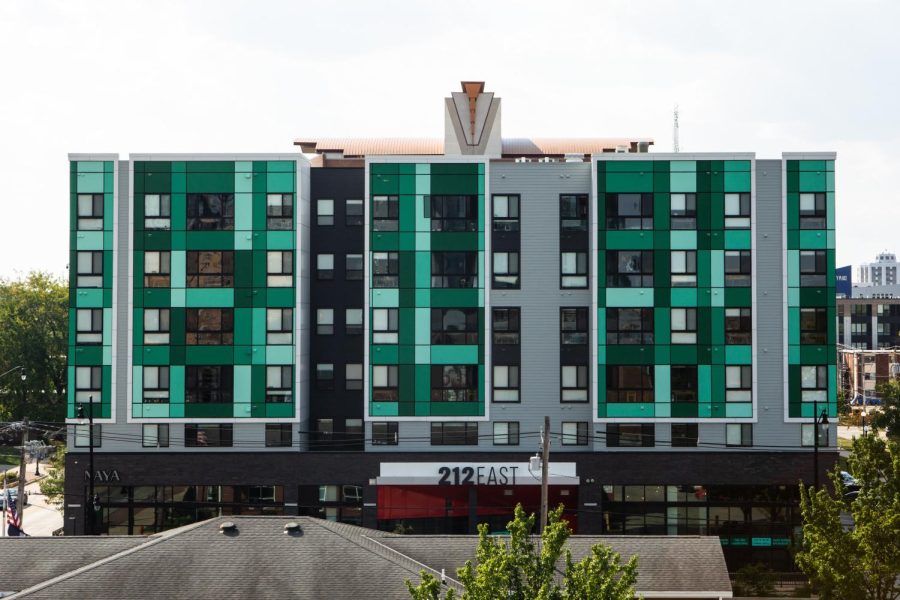Opinion | UI housing market creates disconnect between students
212 East, one of many apartment buildings located on Green Street, allow students to be in a closer range of campus. Columnist Diamond Walker argues that the University should focus more on creating more affordable housing closer to campus in making the student population more connected.
Mar 26, 2022
The heart of Campustown is full of beautiful luxury apartments. Amenities range from gyms and saunas to rooftops and pools. These newly built or renovated apartments are minutes away from the Main Quad, Green Street and various University instructional buildings.
These apartments can range from $900 to $1,500 for a private one-bedroom unit, which is a high price point for the average student. However, many students expect this luxury living, and parents are willing to pay for it.
The University is very proud of the diversity and inclusion of minority student groups, although you can’t see it in everyday campus life.
Creating stratified communities amongst students is dividing the campus socioeconomically by segregating low-income students from high-income students. Many minority students are living in their own communities that were created for them through economic means.
Unsurprisingly, we are not the only university with this disparity in housing. The construction of luxury apartments on campus is a multi-billion-dollar industry and has been expanding over the course of the decade. This is called the “country club phenomenon.”
Get The Daily Illini in your inbox!
There are more affordable apartments and dormitories on campus, although these are located on the outskirts and can be nearly a 15-minute drive and 45-minute walk to the Main Quad and Green Street.
These apartments and dormitories being so far from campus creates a disconnect between economically disadvantaged students and the campus community.
PAR and FAR — the dormitories furthest away from campus — house many minority students.
“It’s hard seeing diversity in your everyday life on campus but when I come back to my dorm I feel included and at home being surrounded with other minorities,” Sayria Mitchell, a sophomore living in PAR, remarked. “There also are multiple cultural events going on that you can’t find within the (other) dormitories.”
Many low-income student housing facilities are located on the outskirts of campus, and some of these units house non-degree-seeking individuals, furthering the detachment a student may feel from Campustown. Putting students in these hidden areas makes it difficult for them to interact with peers outside of the classroom.
Instead of investing in luxury clubhouse apartments, the University should move towards constructing affordable housing near the heart of campus. This would work towards creating an equal experience for all students.
Some get the convenience of living on Green Street next to many restaurants, campus activities and bars — giving them the opportunity to mingle with students while feeling safe inside of their fantasy utopia.
On the other hand, cheaper student living establishments are being faced with acts of gun violence.
On March 2, One South Student Living reported an act of violence that left one woman with severe gunshot wounds to the arm and torso. On March 6, The Retreat at Illinois encountered an act of gun violence, which left one man deceased and another man in critical condition.
Because they were technically off-campus, there were no Illini-Alerts or Massmails to notify students and parents of these incidents. Two student living facilities getting hit with gun violence just a couple of days apart is alarming and should have been addressed by University officials regardless of location.
The first step to resolving these issues is to expand Illini-Alerts to all student apartments. The disparities in campus and community safety have local minority students questioning their protection.
“Does our safety matter to the university, does our black lives matter to the university?” said Jessica McReynolds, a junior with an off-campus apartment.
When items are stolen at resident halls across campus, all of our phones light up and encourage students in the area to find safety. All the while, blood can be shed and lives can be lost in an off-campus student living facility and get overlooked because of its location.
All students’ safety should be a concern to the University, regardless of where they are in Champaign-Urbana. The disparity in the housing market insinuates that some students are more vital to University aesthetics than others.
Building affordable housing in the heart of campus and putting student safety first gives all students an equal opportunity to experience the joys of campus life.
Diamond is a junior in LAS.






